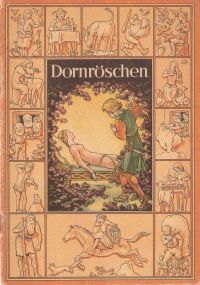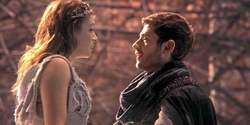|
Storytime by Teresa Martin--@Teresa__Martin Once in the days before, there was a king and queen who wished to have a child. One day, while in her bath, the Queen was visited by a frog from the land of the waters, who announced that she would bring a girl into the world. What the frog said came to be. The baby girl was beautiful, and the King was so filled with happiness that he held a great festival. He invited family and friends, and also the wise women who would give the child sweet and favorable gifts. There were thirteen wise women in his kingdom, but there were only twelve golden plates on which they could eat. Therefore, one of them had to be left behind. This feast was celebrated with great magnificence. Towards the end, the time came for the wise women to give the miraculous gifts. One gave virtue, the second beauty, and the third riches so that the baby would have everything in the world she wished. As the eleventh was about to make her proclamation, the thirteenth wise woman suddenly entered. She wanted revenge for not being invited and cried out with a loud voice that on her fifteenth birthday, the girl would prick her finger on a spindle and fall dead. Without a further word, she turned and walked from the hall. The twelfth wise woman then modified the curse to say that the girl would not die, but fall asleep for a hundred years. The king, not wanting this to befall his daughter, ordered all spindles in his kingdom to be destroyed. Yet upon the girl came all the other gifts that the wise women had prophesied. She had such beauty, goodness, courtesy, grace, and intelligence that everyone who saw her loved her. On the girl’s fifteenth birthday, the parents were away from the castle, and she went throughout the castle exploring everything with enthusiasm. Finally she went to an old tower where there was a woman working a spindle. The Princess asked the old woman what she was doing and the woman answered that she was spinning. As the princess asked what kind of thing it was that went about so merrily, she took it from the old lady, for she wanted to spin herself. No sooner had the girl touched the spindle than she was pricked on her finger. In the blink of an eye, she felt the sting and fell onto a bed into a deep sleep. As the King and Queen returned, they too fell asleep as did everyone else throughout the castle and grounds. Then all around there grew thorny hedges. Every year these hedges grew thicker and thicker, until the whole castle was hidden from sight. As time went on, throughout the land the story spread about the beautiful sleeping princess, Thorn- Rose. From time to time a prince tried to enter the castle through the hedges. But it was not possible because of the thorns, so he would be caught and died a terrible death. After a longer time, a prince heard from an old man about the castle behind a great thorn-hedge. Inside was a beautiful princess named Thorn-Rose who had slept one hundred years. However, many had died trying to get inside. The prince said he was not afraid and would go to see Thorn-Rose. The good old man tried to dissuade him, but the prince would not hear a word. Now the hundred years had passed and it was the day that Thorn-Rose was supposed to awake. When the Prince arrived to where the thorn bushes should be, instead there were large, beautiful flowers, which parted by themselves, and let him pass unharmed. Finally he came to the tower where Thorn-Rose slept. There she lay and looked so beautiful that he could not turn his eyes from her. He approached and gave her a kiss. When his kiss touched her, Thorn-Rose batted her eyes and woke up looking at him with a friendly smile. They went downstairs where all had also awakened. Then there was a wedding between the Prince and Thorn-Rose in all splendor, and they lived happily until their end.* This is the story of “Sleeping Beauty” as written by the Grimm Brothers in the 19th Century. The lovely girl’s name is Dörnroschen, which in English is Thorn-Rose. That name highlights the rose symbol which runs throughout the story. The rose and the thorn have traditionally been associated with great beauty, but also great pain. The expression, “it’s not a rose without the thorns,” while overused, has a rich meaning. There can never be great beauty without great cost. Thorn-Rose’s gifts of comeliness, goodness, courtesy, grace, and intelligence are never acquired without great effort and suffering. Even beauty is its own curse, for those who are physically attractive have the pain of unwanted attention, as well as the uncertainty of never truly knowing if they are loved for their looks, or for who they are. Thorn-Rose experiences this price, one can extrapolate, long before she was pricked by the spindle. It is also notable that Thorn-Rose is not the only one who falls into a deep sleep. The entire household shares in the suffering. They too are surrounded by thorns, showing the great cost of the curse. The Prince, playing the role of the Savior, enters at the moment ordained for the curse to end. Thus the brambles had transformed into roses. His reward is his bride. The wedding between the Prince and Thorn-Rose signals the end of their adversity, and the entire household rejoices. How Thorn-Rose is tricked into pricking her finger on the spindle is worthy of examination. The parallel with Eve in the Garden cannot be avoided. Thorn-Rose is intrigued by the spindle, as Eve is by the apple. Thorn-Rose is entranced by the beauty of the spinning and takes the spindle eagerly. This results in the would-be fatal prick on her finger. It is as though she passes into death, even though she is sleeping. Traditionally the spindle is a symbol of “life and the temporal (Cirlot 304).” That was the fate of Adam and Eve who, in taking the Forbidden Fruit, were cast from an eternal existence into a promise of death. An explicit connection between Adam and Eve with the spindle can be found in the twelfth century Huntenerian Psalter which illustrates this Biblical story. Adam is shown tilling the soil, while Eve is using a spindle. The Disney version of “Sleeping Beauty” is a magnificent work of art. While it is tempting to watch with a focus on the cute fairies, the love story, and the action-packed fight with the dragon, one must deliberately pause to see that this version retains many of the essential themes of the Grimm version. One feels the great pain and joy of knowing that parents are present, yet the insidiousness of Maleficent escalates from a curse to her transformation as a hideous dragon, vomiting out her hatred with the fatal fire. The Prince, Phillip, conquers the dragon, often a symbol of Satan, and receives his well-earned prize: Aurora, his wife. The famous scene in which Aurora and the Phillip meet is delightful. First we hear Aurora’s soprano vocalise, with birds echoing her lyrical voice. Then the scene continues into Aurora’s waltz with the birds into which the Prince cuts. The pair waltzes gracefully together until the song ends when Aurora lays her head on Philip's shoulder and both look to the sunset. The next time the Prince sees Aurora is after he has risked his life for her. The movie ends with all secure in the knowledge that that the engaged couple will be exquisitely happy. Aurora is a very different character from Thorn-Rose. Her name, meaning Dawn, is beautiful and innocent. She does escape into the woods, but with birds and a song. In contrast, Thorn-Rose’s frolic in the castle has the tinge of forbidden fruit as she investigates places to which she had never been. Moreover, she explores while her parents are away. In the movie, Aurora has to be put into a spell to prick her finger, while Thorn- Rose pricks her finger after taking the spindle of her own free will. Yet the stories end in the same manner. The couples get married and live Happily Ever After. This is appropriate as marriage is often used as a symbol in both secular and religious literature of eternal happiness. One could say that this is exactly what is illustrated in the movie since Aurora and her Prince literally dance away into the clouds, as though rising to Heaven. The movie was released in 1959. Fast-forward to September 30th, 2012. Two lone riders gallop toward an eastern-looking castle. They cross a beautiful mosaic floor to approach a pedestal encircled by brambles. This hearkens back to the thorn bushes from the Grimm story. The rose, the Princess, is at the center, but surrounded by thorns. The Prince begins the process of cutting away the pain of separation by slicing through the circle with his sword. As he enters, a small spinning wheel is visible in the corner of the television screen. The Prince leans over the Princess and expresses some doubt about the effectiveness of what he is to do. Regardless, he kisses her. A loud gasp bursts from the Princess, breaking the curse. She calls him Phillip, and he addresses her as Aurora. He attempts to comfort her since she fears that Maleficent will come after her. In a near panic she says that “first she goes after my mother, then me.” Wait! Aurora said that Maleficent went after her mother. Those who have read the Charles Perrault story know what that means! Aurora’s mother is Sleeping Beauty. “The Sleeping Beauty in the Wood,” penned by Charles Perrault, was the first modern edition of the tale written over 150 years before the Grimm version This “Beauty” is never given a name. She is only called “The Princess.” After her sleeping curse is broken by an unnamed Prince, they marry and have two children. One of them is a daughter named Aurora. There are fantastic adventures which follow, including facing an Ogre nemesis. It would appear, given the information from the Season Two premiere, that the writers of Once Upon a Time have decided to use this version as their source. The audience indeed is surprised, as they are by the use of wraiths as enemies. Moreover, Aurora has been supplied with an unlikely companion and rival, Mulan. These two antagonists appear to be set on adventures with more familiar heroines, Mary Margaret and Emma Swan, who are as fantastic to the princesses as Ogres are to the audience. Now, what in the name of Rumplestilskin’s Leather Pants were those wraiths? That is another story altogether. *my personal and rough translation/summary of the Grimm Brothers’ story, “Dörnroschen.“ Works Cited Brüder Grimm. “Dörnroschen. “ Aschenputtel und andere Märchen gesammelt von den Brüdern Grimm. Bonn, Inter Nationes, 1985. Cirlot, J.E. A Dictionary of Symbols, Second Edition. Taylor and Francis e-Library, 2001.
0 Comments
Leave a Reply. |
OriginsExplore the Arthurian legend surrounding Lancelot, take a trip into the woods to discover the mythology behind Red Riding Hood or learn more about a modern day hero called Snow White. Origins provides unique insights and perspectives from talented writers into the characters we know and love, going far beyond the boundaries of Storybrooke. Archives
August 2016
Categories
All
|






